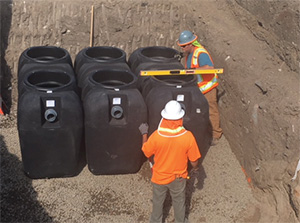Why it’s a good idea on new commercial builds to put the grease interceptor outside.
By Kevin Wong
Recently I had a rather long conversation with a friendly and respected health inspector. I really respect this guy but he challenged me to ask a question, “One interceptor for the facility or many small ones for a strip mall restaurant complex?”
My first thought was “many small ones” as they will all catch the individual sites’ fats, oils and grease (FOG). But what is the fallacy in this thinking? Sure, you’ll sell more interceptors but will it functionally solve the problem you are offering — the solution being FOG interception and diversion from the wastewater stream?
So think of what is in a little strip mall: multiple single-unit restaurants, possibly an auto body garage, and other commercial interests. First, tenants come and go and if a new restaurant comes in, they have to bust up the ground in the unit to put in a small interceptor to meet code or possibly update and upsize the existing one. The interceptor is sized in such a manner that it really can’t predict the future success of the business — thus the produced amount of FOG in a given period.
 Second, user issues. How many times as a young restaurant worker was I asked to flush the grease interceptor with hot water to “clean” it out prior to the health inspector coming in the next day… I won’t tell. Next is the design side of things. The second restaurant comes into the unit, the layout gets changed and often the old interceptor may be kept in the same place for convenience’s sake. To an inexperienced building plans examiner, it is just a check box to meet code — not realizing that there is now a direct line to the very hot wastewater from the [now] nearby commercial dishwasher. Oops.
Second, user issues. How many times as a young restaurant worker was I asked to flush the grease interceptor with hot water to “clean” it out prior to the health inspector coming in the next day… I won’t tell. Next is the design side of things. The second restaurant comes into the unit, the layout gets changed and often the old interceptor may be kept in the same place for convenience’s sake. To an inexperienced building plans examiner, it is just a check box to meet code — not realizing that there is now a direct line to the very hot wastewater from the [now] nearby commercial dishwasher. Oops.
So why don’t landlords just put in a larger grease interceptor outside? First, it is buried, so it is inaccessible to the regular worker. Second, the plan to “clean the thing out prior to inspection” is negated as it is not just a matter of hosing the thing down with some hot water in the privacy of the back of the restaurant space, or below the sink. Third, pumping out the grease can now be optimized to a commercial concern that comes to one central place and since it is outside, there is no business disruption for the individual businesses.
Actually, properly sizing oil, grit and grease interceptors between centralized big and localized smaller ones manage the actual objective of maximizing and effectively managing the interception of materials that can damage our sewer infrastructure.
In reality, some good companies are already viewing the matter this way. Putting the grease interceptor outside just makes good business sense — for pumping, for business disruption, and for peace of mind for the utility and inspector whose job it is functionally to keep FOG out of the system. Finally, it takes stress out of the system for dealing with a piece of equipment that is critical to the environment — rarely a focus for your local restaurateur.
— Kevin Wong is the Canadian national specifications manager with MIFAB. Previously, he spent 12 years as the technical manager for CIPH (Canadian Institute of Plumbing & Heating) and the executive director of CWQA (Canadian Water Quality Association). MIFAB is a manufacturer of specification drainage products, access doors, steel, plastic, concrete and stainless steel trench drains, trap seal primers and water hammer arrestors, HDPE grease, oil and solids interceptors, no hub couplings, BEECO backflow preventers, pressure reducing valves, strainers and gate valves, dialysis boxes and HydroMax siphonic roof drains. Email the author at [email protected].
